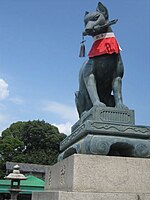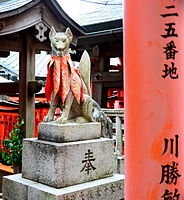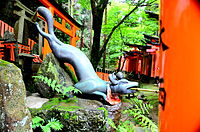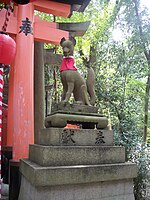| Fushimi Inari-taisha | |
|---|---|
| 伏見稲荷大社 | |
 Torii path with a hanging lantern at Fushimi Inari-Taisha Shrine Torii path with a hanging lantern at Fushimi Inari-Taisha Shrine | |
| Religion | |
| Affiliation | Shinto |
| Deity | Uka-no-Mitama-no-Ōkami, et al. as Inari Ōkami |
| Type | Inari shrine |
| Location | |
| Location | Fushimi-ku, Kyoto, Kyoto, Kyoto Prefecture, Japan |
  | |
| Geographic coordinates | 34°58′2″N 135°46′22″E / 34.96722°N 135.77278°E / 34.96722; 135.77278 |
| Architecture | |
| Style | Kasuga-zukuri |
| Date established | 711 |
| Website | |
| inari | |
Fushimi Inari-taisha (Japanese: 伏見稲荷大社) is the head shrine of the kami Inari, located in Fushimi-ku, Kyoto, Kyoto Prefecture, Japan. The shrine sits at the base of a mountain, also named Inari, which is 233 metres (764 ft) above sea level, and includes trails up the mountain to many smaller shrines which span 4 kilometres (2.5 mi) and take approximately 2 hours to walk up. It is unclear whether the mountain's name, Inariyama, or the shrine's name came first.
Inari was originally and remains primarily the kami of rice and agriculture, but merchants also worship Inari as the patron of business. Each of Fushimi Inari-taisha's roughly 10,000 torii were donated by a Japanese business, and approximately 800 of these are set in a row to form the Senbon Torii, creating the impression of a tunnel. The shrine is said to have ten thousand such gates in total that designate the entrance to the holy domain of kami and protect it against wicked forces.
Owing to the popularity of Inari's division and re-enshrinement, this shrine is said to have as many as 32,000 sub-shrines (分社 bunsha) throughout Japan.
History

The shrine gained imperial patronage during the early Heian period. In 965, Emperor Murakami decreed that messengers carry written accounts of important events to the guardian kami of Japan. These heihaku were initially presented to 16 shrines, including the Inari Shrine.
From 1871 through 1946, Fushimi Inari-taisha was officially designated one of the Kanpei-taisha (官幣大社), meaning that it stood in the first rank of government supported shrines.
Unlike most Shinto shrines, Fushimi Inari-taisha, in keeping with typical Inari shrines, has an open view of the main object of worship (a mirror).
A drawing in Kiyoshi Nozaki's Kitsune: Japan's Fox of Mystery, Romance and Humor in 1786 depicting the shrine says that its two-story entry gate was built by Toyotomi Hideyoshi.
The shrine draws several million worshipers over the Japanese New Year, 2.69 million for 3 days in 2006 reported by the police, the most in western Japan.
Structures
The earliest structures were built in 711 on the Inariyama hill in southwestern Kyoto, but the shrine was re-located in 816 on the request of the monk Kūkai. The main shrine structure was built in 1499. At the bottom of the hill are the main gate (楼門, rōmon, "tower gate") and the main shrine (御本殿, go-honden). Behind them, in the middle of the mountain, the inner shrine (奥宮, okumiya) is reachable by a path lined with thousands of torii. On the way to the top of the mountain are tens of thousands of rock altars (otsuka お塚) for private worship. These rock altars are personalised Inari that have been set up there by citizens. Most of them have individual names for Inari engraved on them.
Senbon Torii
The highlight of the shrine is the rows of torii gates, known as Senbon torii (千本鳥居), "thousand torii". The custom to donate a torii began spreading from the Edo period (1603–1868) to have a wish come true or in gratitude for a wish that came true, with successive gates being added up to the present day by donors out of gratitude. Along the main path there are around 800 torii gates.
Access and environs
The shrine is just outside Inari Station on the Nara Line of the West Japan Railway Company (JR), a five-minute ride from Kyoto Station. It is a short walk from Fushimi-Inari Station on the Main Line of the Keihan Electric Railway.
The shrine is open 24 hours with the approach to the shrine and the Honden (本殿, main hall) itself illuminated all night. There is no entrance fee.
In the approach to the shrine are a number of sweet shops selling tsujiura senbei (辻占煎餅), a form of fortune cookie dating at least to the 19th century, and which are believed by some to be the origin of the American fortune cookie.
In popular culture
| This article is in list format but may read better as prose. You can help by converting this article, if appropriate. Editing help is available. (June 2017) |
- Memoirs of a Geisha (2005)
- Aria the Natural ep. 5 (2006)
- Inari, Konkon, Koi Iroha (2010)
- Rurouni Kenshin, site of Makoto Shishio's base
- Kamen Rider Fourze ep. 33 (2012)
- Samsara (2011 film) (2011)
- The Quintessential Quintuplets (2017)
- High School Inari Tamamo-chan, where the main character a fox spirit came from along with her siblings.
A part of the Noh play Kokaji takes place in Fushimi Inari-taisha.
The shrine inspired Nintendo game designer, Shigeru Miyamoto, to create the series Star Fox. In the series, players control Fox McCloud and fly starfighters through colorful rings in aerial combat. Miyamoto attributed these inspirations to the Fushimi Inari Shrine, which is within walking distance of the Nintendo Kyoto campus.
Gallery
-
 View of the south-western wing of Senbon Torii path.
View of the south-western wing of Senbon Torii path.
-
 View of the north-eastern wing of Senbon Torii path.
View of the north-eastern wing of Senbon Torii path.
-
 A torii path across the mountain from the side
A torii path across the mountain from the side
-
 A honden
A honden
-
 楼門, rōmon, tower gate (main gate)
楼門, rōmon, tower gate (main gate)
-

-

-

-

Fox
Foxes (kitsune), regarded as the messengers, are often found in Inari shrines. One attribute is a key (for the rice granary) in their mouths.
-
 Fox holding a key in its mouth, at the main gate of the Fushimi Inari shrine
Fox holding a key in its mouth, at the main gate of the Fushimi Inari shrine
-
 Fox holding a jewel in its mouth at the main gate of the Fushimi Inari shrine
Fox holding a jewel in its mouth at the main gate of the Fushimi Inari shrine
-
 Fox sculpture in Fushimi Inari-taisha shrine
Fox sculpture in Fushimi Inari-taisha shrine
-
 Fox fountain in Fushimi Inari-taisha shrine
Fox fountain in Fushimi Inari-taisha shrine
-
 Another view of the fox fountain
Another view of the fox fountain
-
 Fox altar in Fushimi Inari-taisha shrine
Fox altar in Fushimi Inari-taisha shrine
-
 Kitsune statue in the Senbon Torii
Kitsune statue in the Senbon Torii
-
 Fox guardian at the Fushimi Inari shrine.
Fox guardian at the Fushimi Inari shrine.
See also
References
- 全国のお稲荷さんの総本宮、伏見稲荷大社を参拝しました。 [Nationwide Inari Shrines, I visited the Fushimi Inari-taisha.] (in Japanese). Retrieved 28 March 2014.
- ^ Keller (2022): 2.
- Keller (2022): 1.
- ^ "伏見稲荷大社にある千本鳥居の由来と数を知りたい". National Diet Library of Japan Collaborative Reference Database. Retrieved 26 March 2023.
- Motegi, Sadazumi. "Shamei Bunpu (Shrine Names and Distributions)". Encyclopedia of Shinto. Retrieved 31 March 2010.
- Breen, John et al. (2000). Shinto in History: Ways of the Kami, pp. 74–75.
- Ponsonby-Fane, Richard. (1962). Studies in Shinto and Shrines, pp. 116–117.
- Ponsonby-Fane, Richard. (1959). The Imperial House of Japan, pp. 124.
- Nussbaum, Louis-Frédéric et al. (1998). Japan encyclopedia, p. 224.
- Smyers (1996): 93-94.
- Fushimi Inari Shrine, How to get there
- Lee, Jennifer 8. (January 16, 2008). "Solving a Riddle Wrapped in a Mystery Inside a Cookie" The New York Times. Retrieved on January 16, 2008.
- 8. Lee, Jennifer (January 16, 2008). "Fortune Cookies are really from Japan". The Fortune Cookie Chronicles official website. Archived from the original on 2011-07-25.
{{cite web}}: CS1 maint: numeric names: authors list (link) - Ono, Gary (2007-10-31). "Japanese American Fortune Cookie: A Taste of Fame or Fortune – Part II". Archived from the original on 2009-04-04. Retrieved 2020-02-16.
- "Kokaji (pamphlet)" (PDF). noh-kyogen.com. Archived from the original (PDF) on 2018-08-20. Retrieved 2018-01-09.
- "Iwata Asks - Nintendo 3DS - Page 3".
Bibliography
- Breen, John and Mark Teeuwen. (2000). Shinto in History: Ways of the Kami. Honolulu: University of Hawaii Press. ISBN 978-0-8248-2363-4
- Keller, Matthew Paul (2022): The Appeal of the Fox: The Cult of Inari and Premodern Japan. University of Southern California.
- Nussbaum, Louis-Frédéric and Käthe Roth. (1998). Japan encyclopedia. Cambridge: Harvard University Press. ISBN 978-0-674-01753-5
- Ponsonby-Fane, Richard. (1962). Studies in Shinto and Shrines. Kyoto: Ponsonby Memorial Society. OCLC 399449
- Ponsonby-Fane, Richard (1959). The Imperial House of Japan. Kyoto: Ponsonby Memorial Society. OCLC 194887
- Smyers, Karen A. (1997). Inari pilgrimage: Following one’s path on the mountain, Japanese Journal of Religious Studies 24 (3–4), 427–452
- Smyers, Karen A. (1996): "My Own Inari": Personalization of the Deity in Inari Worship. Japanese Journal of Religious Studies. 23 (1-2): 85-116.
- Cali, Joseph, and John Dougill. Shinto shrines: a guide to the sacred sites of Japan's ancient religion. University of Hawaii Press, 2012.
External links
- Official website (in Japanese)
- Official website (in English)
- Photographs of Fushimi Inari-taisha on taleofgenji.org
- Accessibility information on Accessible Japan
- 96291583 Fushimi Inari-taisha on OpenStreetMap
| Fushimi-ku, Kyoto | |
|---|---|
| Landmarks | |
| Education | |
| History | |
| Shinto shrines | |||||||||||||||||||||||||||||
|---|---|---|---|---|---|---|---|---|---|---|---|---|---|---|---|---|---|---|---|---|---|---|---|---|---|---|---|---|---|
| |||||||||||||||||||||||||||||
| |||||||||||||||||||||||||||||
| Inari shrines | |||||||
|---|---|---|---|---|---|---|---|
| Gods |
|  | |||||
| Places |
| ||||||
| Misc | |||||||
34°58′02″N 135°46′22″E / 34.96722°N 135.77278°E / 34.96722; 135.77278
Categories: